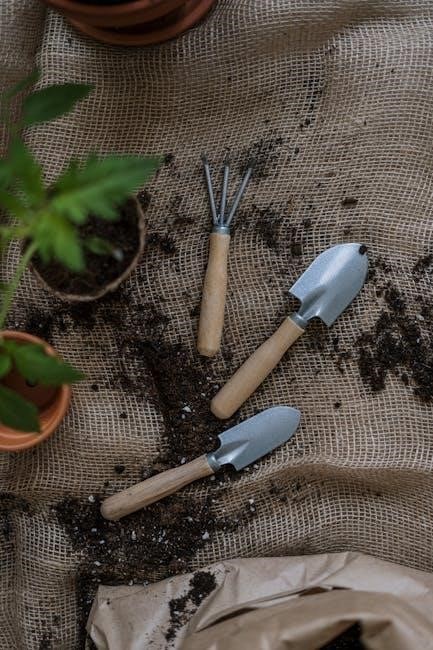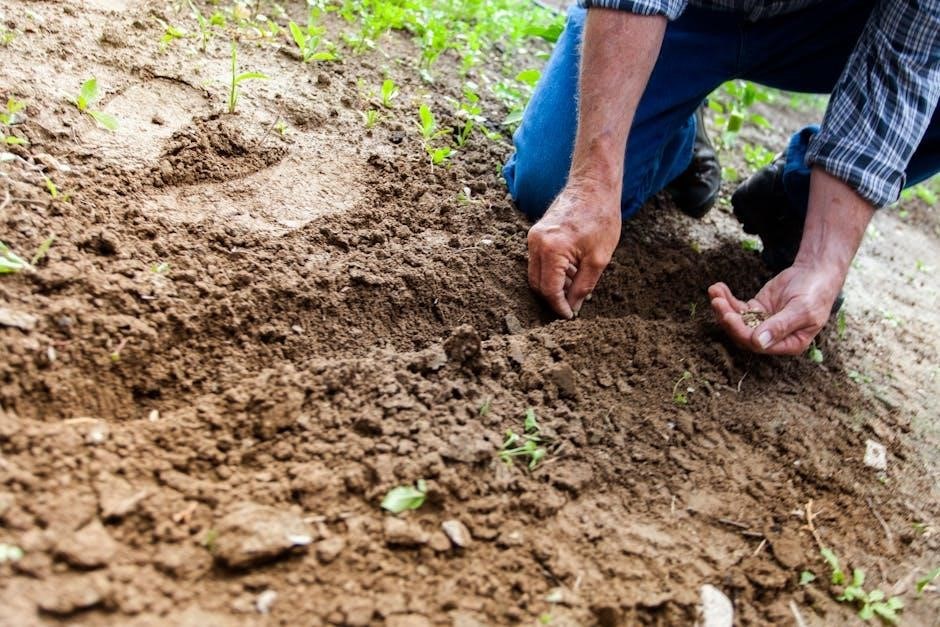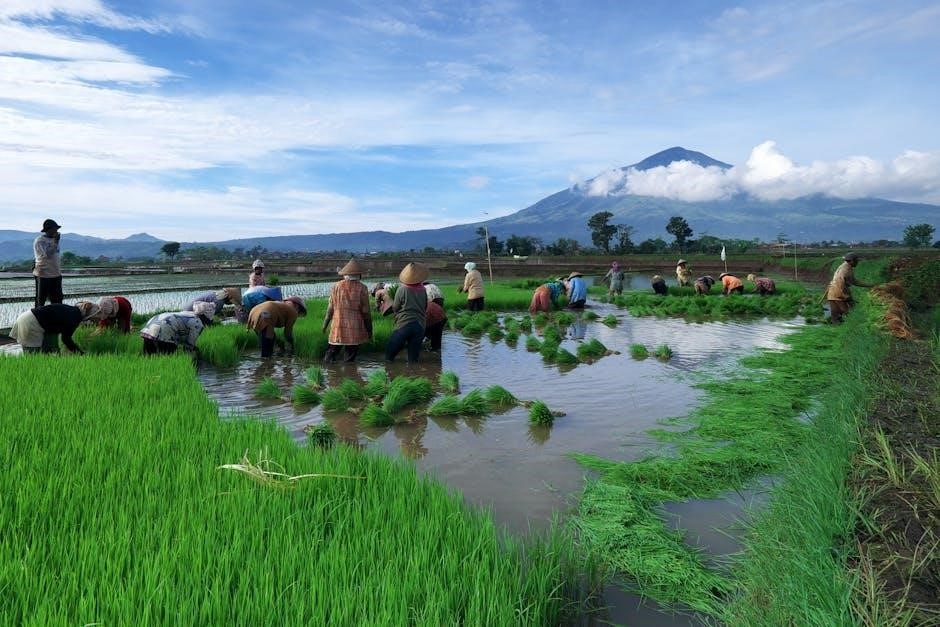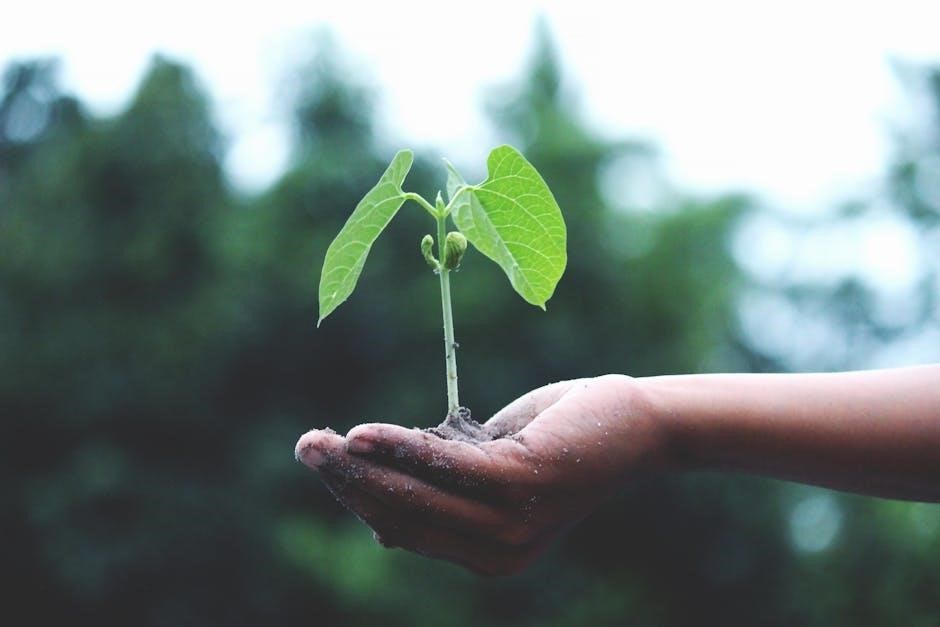Understanding USDA Hardiness Zone 7b
USDA Hardiness Zone 7b covers regions with a minimum winter temperature of 5–10°F‚ offering a medium-length growing season ideal for diverse plant species.
1.1 Overview of Zone 7b Climate
USDA Hardiness Zone 7b is characterized by a moderate climate with warm summers and cool winters. The minimum winter temperature ranges from 5°F to 10°F‚ allowing for a relatively long growing season. This zone experiences mild winters‚ with frost occurring but not persisting for extended periods. Summers are warm but not extreme‚ making it suitable for a wide variety of plants. Zone 7b typically has an average annual precipitation of 30–50 inches‚ distributed fairly evenly throughout the year. The combination of moderate temperatures and ample moisture creates ideal conditions for gardening‚ enabling gardeners to grow both cool-season and warm-season crops. This climate also supports year-round gardening with proper planning and protection.
1.2 Temperature Ranges and Frost Dates
In USDA Hardiness Zone 7b‚ the temperature ranges are moderate‚ with warm summers and cool winters. The average summer highs reach the mid-80s Fahrenheit‚ while winter lows range from 5°F to 10°F. The last spring frost typically occurs around late March to early April‚ and the first fall frost happens in mid to late October. This creates a growing season of approximately 7 months‚ allowing for a wide variety of plants to thrive. The zone’s climate is further characterized by an average annual precipitation of 30–50 inches‚ providing ample moisture for plant growth. Understanding these temperature ranges and frost dates is essential for timing plantings correctly and ensuring a successful garden.

Seasonal Planting Guides
Zone 7b’s moderate climate allows for two primary planting seasons: spring and fall. Spring planting begins after the last frost in late March‚ ideal for warm-weather crops. Fall planting starts in late summer‚ perfect for cool-season crops. This dual-season approach maximizes the growing potential of the zone’s 7-month growing season.
2.1 Spring Planting in Zone 7b
In Zone 7b‚ spring planting typically begins after the last frost date‚ which is around mid-April. This period is ideal for planting warm-season crops like tomatoes‚ peppers‚ and eggplants. Gardeners can start seeds indoors 4-6 weeks before the last frost date to give plants a head start. Popular spring vegetables include zucchini‚ cucumbers‚ and squash‚ while flowers like marigolds and zinnias thrive in the warming temperatures. Soil preparation is key‚ with loosening and adding compost or well-rotted manure to improve fertility. Consistent watering is essential during this period‚ ensuring the soil remains moist but not waterlogged. This season offers a wide variety of planting options‚ making it a busy but rewarding time for gardeners in Zone 7b.
2.2 Fall Planting in Zone 7b
Fall planting in Zone 7b is a great opportunity to grow cool-season crops‚ as the climate cools down after summer. Gardeners can start planting about 8 weeks before the first frost date‚ which is typically around mid-November. Vegetables like broccoli‚ kale‚ spinach‚ and carrots thrive in the cooler temperatures. Additionally‚ pansies and violas are popular choices for fall flowers. Soil preparation is crucial‚ as the ground may be depleted from summer growth. Adding compost or well-rotted manure can replenish nutrients. Avoid over-fertilizing‚ as this can lead to excessive foliage growth at the expense of root development. With proper planning‚ Zone 7b gardeners can enjoy a bountiful harvest well into the fall season.

Soil Preparation and Plant Selection
Proper soil preparation and plant selection are vital for thriving gardens in Zone 7b. The region’s soil typically drains well‚ but adding compost enhances fertility.
3.1 Soil Requirements for Zone 7b
Zone 7b gardens thrive in well-draining‚ fertile soil with a pH between 6.0 and 7.0. Adding compost or organic matter improves soil structure and nutrient content. Ensure good drainage by mixing in sand or gravel‚ especially for plants like edelweiss‚ which prefer neutral to slightly alkaline soil. Avoid heavy clay or waterlogged areas‚ as they can hinder root growth. Testing your soil type and pH annually helps tailor amendments for optimal plant health. For specific plants‚ such as bulbs or perennials‚ slightly acidic to neutral soils are ideal. Proper soil preparation ensures robust growth and vibrant blooms in Zone 7b’s climate.
3.2 Choosing the Right Plants for Zone 7b
Selecting plants suited to Zone 7b ensures a thriving garden. Opt for perennials like peonies‚ which bloom in late spring‚ or edelweiss‚ preferring well-draining‚ neutral soils. Vegetables such as beans‚ okra‚ and squash excel in Zone 7b’s climate. Fruit trees like apples and berries‚ including blackberries and raspberries‚ also perform well. Consider heat tolerance alongside cold hardiness‚ as summers can be warm. Incorporate a mix of annuals and perennials to maintain year-round interest. By aligning plant choices with Zone 7b’s conditions‚ gardeners can enjoy vibrant blooms‚ bountiful harvests‚ and a resilient landscape tailored to the region’s unique climate.
Planting Tips and Care
Zone 7b gardeners should water deeply but avoid overwatering. Ensure plants receive adequate sunlight‚ with most needing at least 6 hours of direct sun daily. Proper placement and spacing are crucial for air circulation‚ reducing disease risks. Sow seeds outdoors when the soil warms sufficiently‚ typically after the last frost date. Regular maintenance‚ including pruning and mulching‚ promotes healthy growth and retains soil moisture. Monitor weather forecasts to protect sensitive plants from extreme conditions.
4.1 Watering and Irrigation Tips

Proper watering is essential for Zone 7b plants. During hot summer months‚ water deeply once or twice a week‚ ensuring the soil is moist but not waterlogged. Avoid frequent shallow watering‚ as it can weaken root systems. Use drip irrigation or soaker hoses to deliver water directly to the roots‚ reducing evaporation and runoff. Mulch around plants to retain soil moisture and regulate temperature. Monitor soil moisture by inserting a finger into the soil up to the knuckle; water only if it feels dry. Adjust watering schedules based on weather conditions‚ such as rainfall or extreme heat. Overwatering can lead to root rot and other issues‚ so balance is key for healthy plant growth in Zone 7b.
4.2 Sunlight and Placement Considerations
In Zone 7b‚ most plants require at least 6 hours of direct sunlight daily for optimal growth. Position plants to maximize sunlight exposure‚ especially during the morning‚ when the sun is less intense. Avoid placing plants in areas where afternoon sun may be too harsh‚ potentially causing stress or scorching. For shade-loving plants‚ ensure they receive filtered sunlight or dappled shade‚ especially during peak heat. Proper spacing is crucial to prevent overcrowding‚ which can hinder light penetration and air circulation. Use trellises or stakes for climbing plants to make the most of sunlight and soil warmth. Consider using a soil thermometer to monitor soil temperature‚ as this can affect seed germination and root health. Adjust placement based on specific plant needs to ensure thriving growth in Zone 7b.

Managing Pests and Diseases
In Zone 7b‚ common pests like aphids‚ slugs‚ and snails can damage plants. Regularly inspect plants and use organic controls like neem oil or hand-picking to prevent infestations.
5.1 Common Pests in Zone 7b
In Zone 7b‚ gardeners often encounter pests like aphids‚ slugs‚ snails‚ and caterpillars‚ which can damage plants. Aphids target tender shoots and leaves‚ while slugs and snails thrive in moist environments‚ feeding on foliage at night. Caterpillars‚ such as those from butterflies and moths‚ can defoliate plants quickly. Other pests include mites‚ scale insects‚ and occasional infestations of beetles. Regular inspection of plants is crucial to identify infestations early. Organic control methods‚ such as neem oil‚ insecticidal soap‚ and hand-picking‚ are effective. Encouraging beneficial insects like ladybugs and lacewings can also help maintain pest balance. Physical barriers‚ like copper tape for slugs‚ and traps can prevent damage. Proper watering and soil health reduce plant stress‚ making them less vulnerable to pests.
5.2 Preventing Diseases in Plants
Preventing diseases in plants is essential for maintaining a healthy garden in Zone 7b. Proper spacing between plants promotes air circulation‚ reducing fungal growth. Watering at the base of plants rather than overhead minimizes moisture on leaves‚ a common breeding ground for diseases. Using disease-resistant plant varieties and rotating crops annually helps break disease cycles. Regularly inspecting plants for signs of infection‚ such as yellowing leaves or black spots‚ allows for early intervention. Treatments like fungicides or removing infected areas can prevent the spread of disease. Additionally‚ maintaining soil health through composting and balanced fertilization strengthens plant immunity. Pruning dead or diseased plant material and disinfecting tools between uses further reduces the risk of infection. These practices ensure a robust and resilient garden.
Additional Resources
Explore the USDA Plant Hardiness Zone Map and local gardening guides for tailored advice on planting in Zone 7b. Utilize online tools and calendars for precise scheduling and plant selection to maximize your gardening success.
6.1 Using the USDA Plant Hardiness Zone Map
The USDA Plant Hardiness Zone Map is an essential tool for gardeners‚ providing a detailed guide to determine which plants thrive in specific regions. By understanding your zone‚ you can select plants suited to your local climate‚ ensuring their survival and optimal growth. This interactive map allows users to input their ZIP code or location‚ offering precise insights into temperature ranges and frost dates. It categorizes areas based on average annual extreme minimum temperatures‚ helping gardeners make informed decisions. Regular updates and detailed zone divisions ensure accuracy‚ making it a reliable resource for both novice and experienced gardeners in Zone 7b and beyond.
6.2 Recommended Planting Calendars and Tools
To maximize your gardening success in Zone 7b‚ utilize reliable planting calendars and tools. The Kellogg Garden Zone Planting Charts provide detailed schedules for sowing‚ planting‚ and harvesting specific vegetables. These resources are tailored to your zone‚ ensuring optimal timing for each crop. Additionally‚ interactive planting calendars and apps offer customizable reminders and planting guides based on your location. The USDA Plant Hardiness Zone Map is another invaluable tool‚ helping you identify plants suited to your area. By combining these resources with local knowledge‚ you can create a personalized gardening plan‚ ensuring your plants thrive throughout the growing season. These tools are essential for both beginners and experienced gardeners aiming to make the most of Zone 7b’s unique conditions.